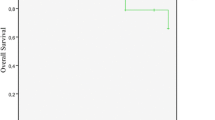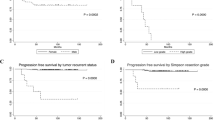Abstract
Postoperative new cranial nerve deficits comprise severe concomitant morbidity in skull base meningioma surgery. Therefore, long-term cranial nerve integrity represents an important outcome measure. In the current study, we analyzed our institutional database in order to identify risk factors for postoperative new cranial nerve morbidity in the course of frontobasal meningioma surgery. Between 2009 and 2017, 195 patients were surgically treated for frontobasal meningioma at the authors’ institution. Postoperative cranial nerve function was assessed immediately after surgery as well as 12 months postoperatively. A univariate and multivariate analysis was performed to identify factors influencing favorable postoperative cranial nerve outcome. Tumors with histological Mib-1-labeling indices > 5% were associated with a significantly higher percentage of new cranial nerve deficits immediately after surgery compared with those with Mib-1-labeling indices ≤ 5% (39% versus 20%, p = 0.029). Elevated Mib-1-labeling indices could be correlated with high CD68-positive macrophage staining (54% for Mib-1 index > 5% versus 19% for Mib-1 index ≤ 5%, p = 0.001). Elevated Mib-1-labeling index correlates with initial new cranial nerve dysfunction after resection of frontal skull base meningioma. With regard to elevated CD68-positive macrophage staining in high Mib-1-positive meningiomas, initial postoperative new cranial nerve morbidity might partly reflect macrophage-based inflammatory immune responses.

Similar content being viewed by others
References
Whittle IR, Smith C, Navoo P, Collie D (2004) Meningiomas. Lancet 363(9420):1535–1543. https://doi.org/10.1016/S0140-6736(04)16153-9
Topsakal C, Al-Mefty O, Bulsara KR, Williford VS (2008) Intraoperative monitoring of lower cranial nerves in skull base surgery: technical report and review of 123 monitored cases. Neurosurg Rev 31(1):45–53. https://doi.org/10.1007/s10143-007-0105-5
Bassiouni H, Asgari S, Sandalcioglu IE, Seifert V, Stolke D, Marquardt G (2009) Anterior clinoidal meningiomas: functional outcome after microsurgical resection in a consecutive series of 106 patients. Clinical article. J Neurosurg 111(5):1078–1090. https://doi.org/10.3171/2009.3.17685
Turgut M, Ozcan OE, Benli K, Ozgen T, Gurcay O, Bertan V, Erbengi A, Saglam S (1996) Factors affecting morbidity and mortality following surgical intervention in patients with intracranial meningioma. Aust N Z J Surg 66(3):144–150. https://doi.org/10.1111/j.1445-2197.1996.tb01143.x
Schneider M, Schuss P, Guresir A, Wach J, Hamed M, Vatter H, Guresir E (2019) Cranial nerve outcomes after surgery for frontal skull base meningiomas: the eternal quest of the maximum-safe resection with the lowest morbidity. World Neurosurg. https://doi.org/10.1016/j.wneu.2019.01.171
Hye RJ, Mackey A, Hill MD, Voeks JH, Cohen DJ, Wang K, Tom M, Brott TG (2015) Incidence, outcomes, and effect on quality of life of cranial nerve injury in the Carotid Revascularization Endarterectomy versus Stenting Trial. J Vasc Surg 61(5):1208–1214. https://doi.org/10.1016/j.jvs.2014.12.039
Chen CM, Huang AP, Kuo LT, Tu YK (2011) Contemporary surgical outcome for skull base meningiomas. Neurosurg Rev 34(3):281–296; discussion 296. https://doi.org/10.1007/s10143-011-0321-x
Louis DN, Perry A, Reifenberger G, von Deimling A, Figarella-Branger D, Cavenee WK, Ohgaki H, Wiestler OD, Kleihues P, Ellison DW (2016) The 2016 World Health Organization classification of tumors of the central nervous system: a summary. Acta Neuropathol 131(6):803–820. https://doi.org/10.1007/s00401-016-1545-1
Majores M, Schick V, Engels G, Fassunke J, Elger CE, Schramm J, Blumcke I, Becker AJ (2005) Mutational and immunohistochemical analysis of ezrin-, radixin-, moesin (ERM) molecules in epilepsy-associated glioneuronal lesions. Acta Neuropathol 110(6):537–546. https://doi.org/10.1007/s00401-005-1088-3
Majores M, von Lehe M, Fassunke J, Schramm J, Becker AJ, Simon M (2008) Tumor recurrence and malignant progression of gangliogliomas. Cancer 113(12):3355–3363. https://doi.org/10.1002/cncr.23965
Neil-Dwyer G, Lang DA, Davis A (2000) Outcome from complex neurosurgery: an evidence based approach. Acta Neurochir 142(4):367–371
Okada M, Miyake K, Matsumoto Y, Kawai N, Kunishio K, Nagao S (2004) Matrix metalloproteinase-2 and matrix metalloproteinase-9 expressions correlate with the recurrence of intracranial meningiomas. J Neuro-Oncol 66(1–2):29–37
Perry A, Stafford SL, Scheithauer BW, Suman VJ, Lohse CM (1998) The prognostic significance of MIB-1, p53, and DNA flow cytometry in completely resected primary meningiomas. Cancer 82(11):2262–2269
Takahashi JA, Ueba T, Hashimoto N, Nakashima Y, Katsuki N (2004) The combination of mitotic and Ki-67 indices as a useful method for predicting short-term recurrence of meningiomas. Surg Neurol 61(2):149–155 discussion 155-146
Maiuri F, De Caro MB, Esposito F, Cappabianca P, Strazzullo V, Pettinato G, de Divitiis E (2007) Recurrences of meningiomas: predictive value of pathological features and hormonal and growth factors. J Neuro-Oncol 82(1):63–68. https://doi.org/10.1007/s11060-005-9078-9
Vankalakunti M, Vasishta RK, Das Radotra B, Khosla VK (2007) MIB-1 immunolabeling: a valuable marker in prediction of benign recurring meningiomas. Neuropathology 27(5):407–412
Zandian A, Osiro S, Hudson R, Ali IM, Matusz P, Tubbs SR, Loukas M (2014) The neurologist’s dilemma: a comprehensive clinical review of Bell’s palsy, with emphasis on current management trends. Med Sci Monit 20:83–90. https://doi.org/10.12659/MSM.889876
Ciorba A, Corazzi V, Conz V, Bianchini C, Aimoni C (2015) Facial nerve paralysis in children. World J Clin Cases 3(12):973–979. https://doi.org/10.12998/wjcc.v3.i12.973
Biebl A, Lechner E, Hroncek K, Preisinger A, Eisenkolbl A, Schmitt K, Furthner D (2013) Facial nerve paralysis in children: is it as benign as supposed? Pediatr Neurol 49(3):178–181. https://doi.org/10.1016/j.pediatrneurol.2013.03.013
Cattoretti G, Becker MH, Key G, Duchrow M, Schluter C, Galle J, Gerdes J (1992) Monoclonal antibodies against recombinant parts of the Ki-67 antigen (MIB 1 and MIB 3) detect proliferating cells in microwave-processed formalin-fixed paraffin sections. J Pathol 168(4):357–363. https://doi.org/10.1002/path.1711680404
Strik HM, Stoll M, Meyermann R (2004) Immune cell infiltration of intrinsic and metastatic intracranial tumours. Anticancer Res 24(1):37–42
Rossi ML, Cruz Sanchez F, Hughes JT, Esiri MM, Coakham HB (1988) Immunocytochemical study of the cellular immune response in meningiomas. J Clin Pathol 41(3):314–319
Lewis D, Roncaroli F, Agushi E, Mosses D, Williams R, Li KL, Zhu X, Hinz R, Atkinson R, Wadeson A, Hulme S, Mayers H, Stapleton E, Lloyd SKL, Freeman SR, Rutherford SA, Hammerbeck-Ward C, Evans DG, Pathmanaban O, Jackson A, King AT, Coope D (2018) Inflammation and vascular permeability correlate with growth in sporadic vestibular schwannoma. Neuro-Oncology. https://doi.org/10.1093/neuonc/noy177
Korshunov A, Shishkina L, Golanov A (2003) Immunohistochemical analysis of p16INK4a, p14ARF, p18INK4c, p21CIP1, p27KIP1 and p73 expression in 271 meningiomas correlation with tumor grade and clinical outcome. Int J Cancer 104(6):728–734. https://doi.org/10.1002/ijc.11013
Roser F, Samii M, Ostertag H, Bellinzona M (2004) The Ki-67 proliferation antigen in meningiomas. Experience in 600 cases. Acta Neurochir 146(1):37–44; discussion 44. https://doi.org/10.1007/s00701-003-0173-4
Shimada S, Ishizawa K, Hirose T (2005) Expression of E-cadherin and catenins in meningioma: ubiquitous expression and its irrelevance to malignancy. Pathol Int 55(1):1–7. https://doi.org/10.1111/j.1440-1827.2005.01786.x
Moradi A, Semnani V, Djam H, Tajodini A, Zali AR, Ghaemi K, Nikzad N, Madani-Civi M (2008) Pathodiagnostic parameters for meningioma grading. J Clin Neurosci 15(12):1370–1375. https://doi.org/10.1016/j.jocn.2007.12.005
Morimura T, Kitz K, Budka H (1989) In situ analysis of cell kinetics in human brain tumors. A comparative immunocytochemical study of S phase cells by a new in vitro bromodeoxyuridine-labeling technique, and of proliferating pool cells by monoclonal antibody Ki-67. Acta Neuropathol 77(3):276–282
Prayson RA (2005) The utility of MIB-1/Ki-67 immunostaining in the evaluation of central nervous system neoplasms. Adv Anat Pathol 12(3):144–148
Abry E, Thomassen IO, Salvesen OO, Torp SH (2010) The significance of Ki-67/MIB-1 labeling index in human meningiomas: a literature study. Pathol Res Pract 206(12):810–815. https://doi.org/10.1016/j.prp.2010.09.002
Author information
Authors and Affiliations
Corresponding author
Ethics declarations
Conflict of interest
The authors declare that they have no conflict of interest.
Ethical approval
The present study was approved by the local ethics committee of the University of Bonn.
Informed consent
Informed consent was not sought as a retrospective design was used.
Additional information
Publisher’s note
Springer Nature remains neutral with regard to jurisdictional claims in published maps and institutional affiliations.
Electronic supplementary material
ESM 1
(DOCX 18 kb)
Rights and permissions
About this article
Cite this article
Schneider, M., Borger, V., Güresir, Á. et al. High Mib-1-score correlates with new cranial nerve deficits after surgery for frontal skull base meningioma. Neurosurg Rev 44, 381–387 (2021). https://doi.org/10.1007/s10143-019-01222-0
Received:
Revised:
Accepted:
Published:
Issue Date:
DOI: https://doi.org/10.1007/s10143-019-01222-0




